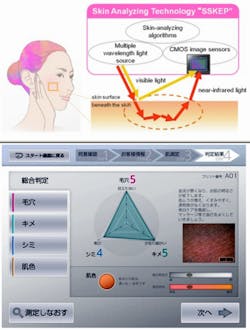Sony develops skin sensor
Engineers at Sony Corporation (Tokyo, Japan) have developed a system for analyzing various elements of the skin, including texture, blemishes, pores, brightness and coloring.
An important aspect of any skin analysis system is its ability to examine both the surface layer of the skin with visible light, as well as the layers beneath the skin with near-infrared light.
The Sony Smart Skin Evaluation Program (SSKEP) system achieves this goal by illuminating the skin with multiple wavelength light sources, capturing the image data on back-illuminated CMOS image sensors and using skin-analyzing algorithms to measure and analyze various elements of the skin.
Sony's own algorithms enable skin texture to be evaluated by analyzing its shape, volume and direction. Furthermore, pigmentation on, and beneath, the surface of the skin can be viewed by conducting a pixel-by-pixel analysis of melanin in the skin, thus enabling information to be obtained about concealed markings and blemishes.
Sony anticipates that the SSKEP system will be used in new consumer products in the beauty industry. Its engineers plan to continue develop and enhance the technology.
Related articles from Vision Systems Design that you might also be interested in.
1. Imaging technique shows nanoparticles do not penetrate skin
Research by scientists at Bath University (Bath, UK) is challenging claims that nanoparticles in medicated and cosmetic creams are able to transport and deliver active ingredients deep inside the skin.
2. Imaging system gets under the skin
Researchers from Medical University Vienna (MUW; Vienna, Austria) and the Ludwig-Maximilians University (Munich, Germany) have used optical coherence tomography (OCT) to noninvasively image the network of blood vessels beneath the outer layer of skin, potentially revealing telltale signs of disease.
3. Software helps classify skin cancer
Researchers at the University of Edinburgh (Edinburgh, UK) have developed diagnostic software that can help health care workers to correctly identify different types of skin lesions, leading to more effective diagnosis of skin cancer.
4. Mobile app helps track moles
A new free app developed at the University of Michigan Health System (Ann Arbor, MI, USA) allows users to photograph suspicious moles or other skin lesions which they can then share with a dermatologist to obtain a medical diagnosis.
Vision Systems Design magazine and e-newsletter subscriptions are free to qualified professionals. To subscribe, please complete the form here.
-- Dave Wilson, Senior Editor, Vision Systems Design
